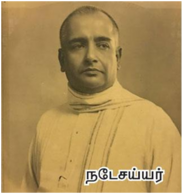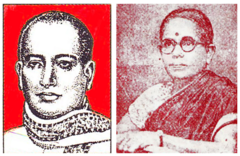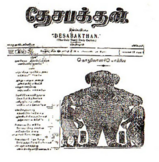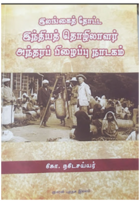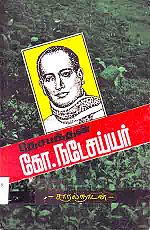K. Natesa Iyer: Difference between revisions
Priyamvada r (talk | contribs) No edit summary |
Priyamvada r (talk | contribs) No edit summary |
||
| Line 3: | Line 3: | ||
K. Natesa Iyer (January 14, 1887 – November 7, 1947) was born in Tamil Nadu and lived in | K. Natesa Iyer (January 14, 1887 – November 7, 1947) was born in Tamil Nadu and lived in Malaiyaha (Sri Lanka). He was a Tamil scholar, publisher, politician, journalist and writer. He was a pioneer of the trade union movement in Sri Lanka. | ||
== Early Life & Education == | == Early Life & Education == | ||
Kothandarama Natesa Iyer was born on January 14, 1887 to Kothandarama Iyer and Bhagirathammal at Valavanur in Villupuram (then South Arcot) district of Tamil Nadu. Kindled by a nationalist spirit at the time of the Bengal partition, Natesa Iyer who was studying in an English medium government school, dropped out in 1907. He joined the Government Training Institute, Chennai and underwent vocational training. Natesa Iyer took up weaving for some time before obtaining a diploma in commerce. He worked as a vocational education teacher at Kalyanasundaram Higher Secondary School, Thanjavur for a few years. Natesa Iyer was fluent in Tamil and English languages. | Kothandarama Natesa Iyer was born on January 14, 1887 to Kothandarama Iyer and Bhagirathammal at Valavanur in Villupuram (then South Arcot) district of Tamil Nadu. Kindled by a nationalist spirit at the time of the Bengal partition, Natesa Iyer who was studying in an English medium government school, dropped out in 1907. He joined the Government Training Institute, Chennai and underwent vocational training. Natesa Iyer took up weaving for some time before obtaining a diploma in commerce. He worked as a vocational education teacher at Kalyanasundaram Higher Secondary School, Thanjavur for a few years. Natesa Iyer was fluent in Tamil and English languages. | ||
== Private Life == | == Private Life == | ||
[[File:நடேசய்யர் மனைவி மீனாட்சியுடன்.png|thumb|240x240px|Natesa Iyer with his wife Meenakshi]] | [[File:நடேசய்யர் மனைவி மீனாட்சியுடன்.png|thumb|240x240px|Natesa Iyer with his wife Meenakshi]] | ||
Natesa Iyer | After the death of his first wife, Natesa Iyer married the Malaiyaha Tamil poet, writer and social activist, Meenakshi Ammal. Notably, she campaigned for women's suffrage. Natesa Iyer and Meenakshi Ammal visited Sri Lanka in 1920. When he learned about the enslavement of the Malaiyaha workers, he decided to stay back in the country and devoted his life to the Malaiyaha Tamils. | ||
Natesa Iyer | Prior to that, Natesa Iyer was instrumental in the founding of the South Indian Merchants Association, South Indian Mill Owners Association, Thanjavur District Rice Mill Owners Association and many more in India, between 1914 and 1915. He expanded the [[Varthaka Mithran|''Varthaka Mithran'']] magazine's membership to Sri Lanka too. Natesa Iyer visited Colombo in 1919, to participate in the annual event of South Indian Merchants Association. | ||
In 1930, Natesa Iyer settled down in Hatton town at the foot of the Malaiyaha plantations. This allowed him to visit the tea estates often and address its people. Along with Natesa Iyer, his wife Meenakshi Ammai also worked for the welfare of the plantation workers. '<nowiki/>''Thozhilalar Chattakkumi''' is one of the popular songs they composed for the workers. | |||
== Political Life == | == Political Life == | ||
Natesa Iyer’s political | Natesa Iyer’s political roots were with the Congress. Natesa Iyer contested the Ceylon legislative assembly elections held in 1924, and lost. In the 1936 he was elected to the Ceylon State Council from the Hatton constituency. He remained a member of the Indian National Congress in Sri Lanka until 1947. In the parliamentary elections held in August and September 1947, Natesa Iyer contested from Maskeliya constituency but lost. | ||
== Publication Service == | == Publication Service == | ||
[[File:தேசபக்தன் இதழ்.png|thumb|162x162px|Deshabhaktan Magazine]] | [[File:தேசபக்தன் இதழ்.png|thumb|162x162px|Deshabhaktan Magazine]] | ||
Natesa Iyer started | in 1914, Natesa Iyer started [[Varthaka Mithran|''Varthaka Mithran'']], a journal for merchants, with the objective of encouraging Indians to rise up against the domination of the British in commerce. Natesa Iyer founded ''[[Deshanesan]]'', the first Tamil daily in Sri Lanka in 1921. He released a new set of Malaiyaha aathichoodi poems (a collection of single-line quotations written and organized in alphabetical order. In Tamil it was written by Avvaiyar) on the cover page of ''[[Deshabhaktan]]'', a magazine. Through his publications, Natesa Iyer spread Bharathiyar's songs throughout Sri Lanka. | ||
Deshanesan | ''Deshanesan'' was the first to investigate and bring to light the plight of the Indian workers in Ceylon. Natesa Iyer started an English weekly, ''The Citizen'', to delve into the tribulations of the Indian Tamils in Colombo. In 1931, Natesa Iyer founded the All Sri Lanka Plantation Workers Union at Hatton. | ||
== Literary Service == | == Literary Service == | ||
'Natesa Iyer is known as the father of Malaiyaha literature' says [[Jeyamohan]]<ref>[https://www.jeyamohan.in/41452/ 'Udhirintha Rathathuligalin Kathai', Jeyamohan, Forword to Pin Meengal - Collection of Short Stories of Thelivathai Joseph]</ref>. Natesa Iyer wrote industry specific books - ''Insurance'', ''Oil Engines'' and ''Vangigalum Avatrai Nirvagikum Muraigalum'' (Banks and How to Manage Them), being a few of them. He also wrote a novel ''Otran'' (Spy). Natesa Iyer ran a printing press ''Sahodari'' (Sister) in Hatton town and continued to publish his and his wife's books through it. | |||
Natesa Iyer published a book ''Bhupendrasingal | In 1993, Natesa Iyer published a book ''Bhupendrasingal Alladhu Narendrapathiyin Naraha Vazhkai'', documenting the deeds of the Maharaja of Patiala (India) in two volumes. This book was banned in India. | ||
== Death == | == Death == | ||
Natesa Iyer passed away in November 7, 1947 due to heart attack | Natesa Iyer passed away in Sri Lanka on November 7, 1947 due to a heart attack. | ||
== Literary Contributions == | == Literary Contributions == | ||
[[File:வெளியீடு 1941.png|thumb|201x201px|Publication 1941]] | [[File:வெளியீடு 1941.png|thumb|201x201px|Publication 1941]] | ||
[[File:கோ.நடேசய்யர் வாழ்க்கை வரலாறு (1988).png|thumb|Deshabhaktan K. Natesa Iyer - Biography (1988) ]] | [[File:கோ.நடேசய்யர் வாழ்க்கை வரலாறு (1988).png|thumb|Deshabhaktan K. Natesa Iyer - Biography (1988) ]] | ||
===== Magazines ===== | ===== Magazines ===== | ||
* [[Varthaka Mithran]] (1914) | * [[Varthaka Mithran|''Varthaka Mithran'']] (1914) | ||
* [[Deshanesan]] (1922-23) | * ''[[Deshanesan]]'' (1922-23) | ||
* [[Deshabhaktan]] (1924-29) | * ''[[Deshabhaktan]]'' (1924-29) | ||
* Thozhilali (1929) | * ''Thozhilali'' (1929) | ||
* Thotath Thozhilali (1947) | * ''Thotath Thozhilali'' (1947) | ||
* Urimeippor | * ''Urimeippor'' | ||
* Suthandrappor | * ''Suthandrappor'' | ||
* Veeran Suthandiran | * ''Veeran Suthandiran'' | ||
* Citizen (1922) | * Citizen (1922) | ||
* Forward (1926) | * Forward (1926) | ||
| Line 41: | Line 43: | ||
* Indian Estate Labour (1929) | * Indian Estate Labour (1929) | ||
===== Books ===== | ===== Books ===== | ||
* | * Insurance (1910) | ||
* | * Oil Engines (1910) | ||
* ''Vangihalum Avatrai Nirvahikum Muraigalum'' (1910) | * ''Vangihalum Avatrai Nirvahikum Muraigalum'' (1910) | ||
* ''Kanakup Pathivu Nool'' (1914, Thanjavur) | * ''Kanakup Pathivu Nool'' (1914, Thanjavur) | ||
Revision as of 13:30, 27 April 2022
இந்தப் பக்கத்தை தமிழில் வாசிக்க: கோ. நடேசய்யர்
K. Natesa Iyer (January 14, 1887 – November 7, 1947) was born in Tamil Nadu and lived in Malaiyaha (Sri Lanka). He was a Tamil scholar, publisher, politician, journalist and writer. He was a pioneer of the trade union movement in Sri Lanka.
Early Life & Education
Kothandarama Natesa Iyer was born on January 14, 1887 to Kothandarama Iyer and Bhagirathammal at Valavanur in Villupuram (then South Arcot) district of Tamil Nadu. Kindled by a nationalist spirit at the time of the Bengal partition, Natesa Iyer who was studying in an English medium government school, dropped out in 1907. He joined the Government Training Institute, Chennai and underwent vocational training. Natesa Iyer took up weaving for some time before obtaining a diploma in commerce. He worked as a vocational education teacher at Kalyanasundaram Higher Secondary School, Thanjavur for a few years. Natesa Iyer was fluent in Tamil and English languages.
Private Life
After the death of his first wife, Natesa Iyer married the Malaiyaha Tamil poet, writer and social activist, Meenakshi Ammal. Notably, she campaigned for women's suffrage. Natesa Iyer and Meenakshi Ammal visited Sri Lanka in 1920. When he learned about the enslavement of the Malaiyaha workers, he decided to stay back in the country and devoted his life to the Malaiyaha Tamils.
Prior to that, Natesa Iyer was instrumental in the founding of the South Indian Merchants Association, South Indian Mill Owners Association, Thanjavur District Rice Mill Owners Association and many more in India, between 1914 and 1915. He expanded the Varthaka Mithran magazine's membership to Sri Lanka too. Natesa Iyer visited Colombo in 1919, to participate in the annual event of South Indian Merchants Association.
In 1930, Natesa Iyer settled down in Hatton town at the foot of the Malaiyaha plantations. This allowed him to visit the tea estates often and address its people. Along with Natesa Iyer, his wife Meenakshi Ammai also worked for the welfare of the plantation workers. 'Thozhilalar Chattakkumi' is one of the popular songs they composed for the workers.
Political Life
Natesa Iyer’s political roots were with the Congress. Natesa Iyer contested the Ceylon legislative assembly elections held in 1924, and lost. In the 1936 he was elected to the Ceylon State Council from the Hatton constituency. He remained a member of the Indian National Congress in Sri Lanka until 1947. In the parliamentary elections held in August and September 1947, Natesa Iyer contested from Maskeliya constituency but lost.
Publication Service
in 1914, Natesa Iyer started Varthaka Mithran, a journal for merchants, with the objective of encouraging Indians to rise up against the domination of the British in commerce. Natesa Iyer founded Deshanesan, the first Tamil daily in Sri Lanka in 1921. He released a new set of Malaiyaha aathichoodi poems (a collection of single-line quotations written and organized in alphabetical order. In Tamil it was written by Avvaiyar) on the cover page of Deshabhaktan, a magazine. Through his publications, Natesa Iyer spread Bharathiyar's songs throughout Sri Lanka.
Deshanesan was the first to investigate and bring to light the plight of the Indian workers in Ceylon. Natesa Iyer started an English weekly, The Citizen, to delve into the tribulations of the Indian Tamils in Colombo. In 1931, Natesa Iyer founded the All Sri Lanka Plantation Workers Union at Hatton.
Literary Service
'Natesa Iyer is known as the father of Malaiyaha literature' says Jeyamohan[1]. Natesa Iyer wrote industry specific books - Insurance, Oil Engines and Vangigalum Avatrai Nirvagikum Muraigalum (Banks and How to Manage Them), being a few of them. He also wrote a novel Otran (Spy). Natesa Iyer ran a printing press Sahodari (Sister) in Hatton town and continued to publish his and his wife's books through it.
In 1993, Natesa Iyer published a book Bhupendrasingal Alladhu Narendrapathiyin Naraha Vazhkai, documenting the deeds of the Maharaja of Patiala (India) in two volumes. This book was banned in India.
Death
Natesa Iyer passed away in Sri Lanka on November 7, 1947 due to a heart attack.
Literary Contributions
Magazines
- Varthaka Mithran (1914)
- Deshanesan (1922-23)
- Deshabhaktan (1924-29)
- Thozhilali (1929)
- Thotath Thozhilali (1947)
- Urimeippor
- Suthandrappor
- Veeran Suthandiran
- Citizen (1922)
- Forward (1926)
- Indian Opinion (1936)
- Indian Estate Labour (1929)
Books
- Insurance (1910)
- Oil Engines (1910)
- Vangihalum Avatrai Nirvahikum Muraigalum (1910)
- Kanakup Pathivu Nool (1914, Thanjavur)
- Otran (Novel, 1914)
- Vetri Unadhe
- Nee Mayanguvaden (Collection of Essays, 1931)
- Elankai Thota Indiath Thozhilalar Antharap Pizhaipu Nadaham (1941, Second Edition: 2018)
- India Elankai Opantham (1941)
- Thozhilalar Satta Puthagam (1942)
- Azhahiya Elankai (1944)
- Indo Ceylon Crisis (1941)
- Kathirkamam (1946)
Published Books
- Indiath Thozhilalar Thuyarangal - Compilation of Poems (1933). Meenakshi Ammai
- Indiarhaladu Elankai Vazhkaiyin Nilamei (1940) - Meenakshi Ammai
Reference
- Deshabhaktan K. Natesa Iyer - Keetru (online magazine)
- Deshabhaktan K. Natesa Iyer - Biography (1988) - Author: Saral Nadan
- Natesa Iyer's Sociosphere – A View : Sattatharani E. Thampaiah
